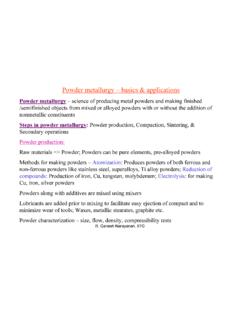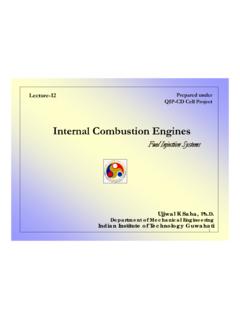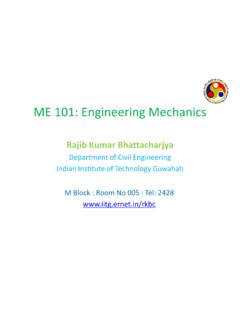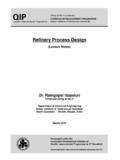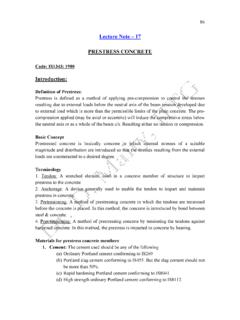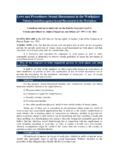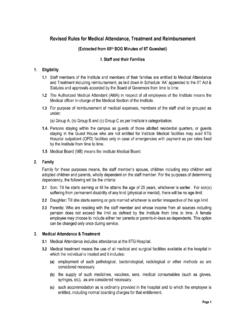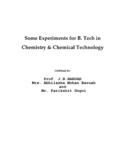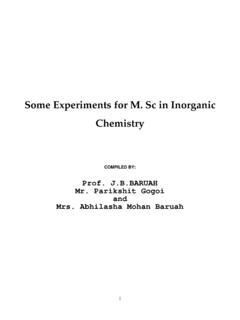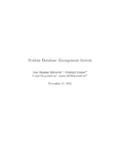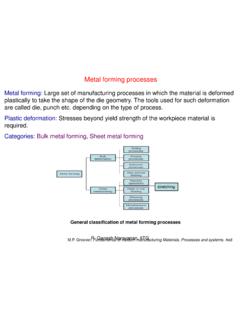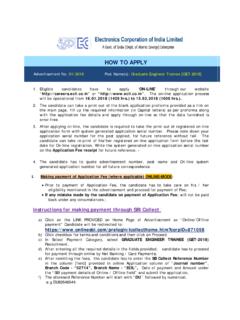Transcription of ANALOG & DIGITAL ELECTRONICS
1 ANALOG & DIGITAL ELECTRONICS . Course No: PH-218. 3-1-0-8. Course Instructor: Dr. Vajpeyi E-mail: Room No: #305. Department of Physics, Indian Institute of Technology Guwahati, India Prerequisite (Nil). Syllabus for ANALOG ELECTRONICS 1. P-N Junctions: Diode theory, forward and reverse-biased junctions, reverse-bias breakdown, load line analysis, diode applications - Limiters, clippers, clampers, voltage multipliers, half wave & full wave rectification, Special purpose diodes - Zener diode, Varactor, light emitting diodes, Laser diodes. 2. Bipolar Junction Transistors (BJT): Transistor fundamentals, transistor configurations, DC operating point, BJT characteristics & parameters, fixed bias, emitter bias with and without emitter resistance, analysis of above circuits and their design, variation of operating point and its stability. 3. Field-Effect Transistors (FET): JFET- current-voltage characteristics, effects in real devices, high-frequency and high-speed issues. Syllabus for ANALOG ELECTRONICS (Contd.)
2 4. Transistors Amplifier: Small Signal BJT amplifiers: AC equivalent circuit, hybrid, re model and their use in amplifier amplifiers, frequency response of basic & compound configuration, Power amplifiers: Class A, B, AB, C and D stages, IC output stages. 5. Feedback & Oscillator Circuits : Effect of positive and negative feedbacks, basic feedback topologies & their properties, Analysis of practical feedback amplifiers, Sinusodial Oscillators (RC, LC and Crystal), Multivibrators, The 555 timer. 6. Operational Amplifiers: Op-Amp Basics, practical Op-Amp circuits, differential and Common mode operation, Inverting & Non Inverting Amplifier, differential and cascade amplifier, Op-Amp applications. Syllabus for DIGITAL ELECTRONICS 7. Number Systems: Decimal, binary, octal, hexadecimal number system and conversion , binary weighted codes, signed numbers, 1s and 2s complement codes, Binary arithmetic 8. Boolean Algebra: Binary logic functions , Boolean laws, truth tables, associative and distributive properties, DeMorgans theorems, realization of switching functions using logic gates 9.
3 Combinational Logic: Switching equations, canonical logic forms, sum of product & product of sums, Karnaugh maps, two, three and four variable Karnaugh maps, simplification of expressions, Quine-McCluskey minimization technique, mixed logic combinational circuits, multiple output functions. 10. Analysis & design of Combinational Logic: Introduction to combinational circuits, code conversions, decoder, encoder, priority encoder, multiplexers as function generators, binary adder, substractor, BCD. adder, Binary comparator, arithmetic logic units Syllabus for DIGITAL ELECTRONICS (Contd.). 11. Sequential Logic: Sequential circuits, flip-flops, clocked and edge triggered flipflops, timing specifications, asynchronous and synchronous counters, counter design with state equations, Registers , serial in serial out shift registers, tristate registor, timing considerations. 12. Sequential Circuits: State diagrams and tables, transition table, excitation table and equations. Examples using flip-flops.
4 Analysis of simple synchronous sequential circuits, construction of state diagram, counter design. 13. Programmable Logic: Programmable logic devices, programmable read only memory, programmable logic arrays and programmable array logic, Design using PLA, field programmable gate a arrays. 14. DIGITAL integrated circuits: Logic levels, propagation delay time, power dissipation fan-out and fan-in, noise margin, logic families and their characteristics TTL, LSTTL CMOS and ECL integrated circuits and their performance comparison, open collector and tristate gates and buffers. Texts: 1. Sedra & , Microelectronics Circuits, Oxford University Press (1997). 2. Malvino, electronic Principles, Tata Mcgraw Hill Publications 3. Robert L. Boylestad & Louis Nashelsky, electronic Devices & Circuit Theory 4. William Kleitz, DIGITAL ELECTRONICS , Prentice Hall International Inc. References: 1. M. S. Tyagi, Introduction to Semiconductor Materials and Devices, John Wiley &. Sons Inc. 2. Michael Shur, Introduction to electronic Devices, John Wiley & Sons Inc.
5 , 2000. 3. R. T. Howe and C. G. Sodini, Microelectronics: An Integrated Approach, Prentice- Hall Inc. 1997. 4. Jacob Millman, and Halkias, electronic devices and circuits , TMH. Publications. 5. Ben G. Streetman, Solid State electronic Devices, PHI, 5th Ed, 2001. Lecture Schedule Room No: 4212. Lectures: Monday: 10:00 -10:55 Hrs Tuesday: 11:00 -11:55 Hrs Friday: 09:00 -09:55 Hrs Tutorial : Hrs Evaluation Strategy Grading will be based on the following: Random Quiz's - 5 (10 marks). Best of three will be counted Informed Quiz - 2 (10 marks each). Mid semester examination (30 marks). End semester examination (40 marks). Minimum 75% attendance compulsory (institutional requirement: your attendance is your responsibility!).
